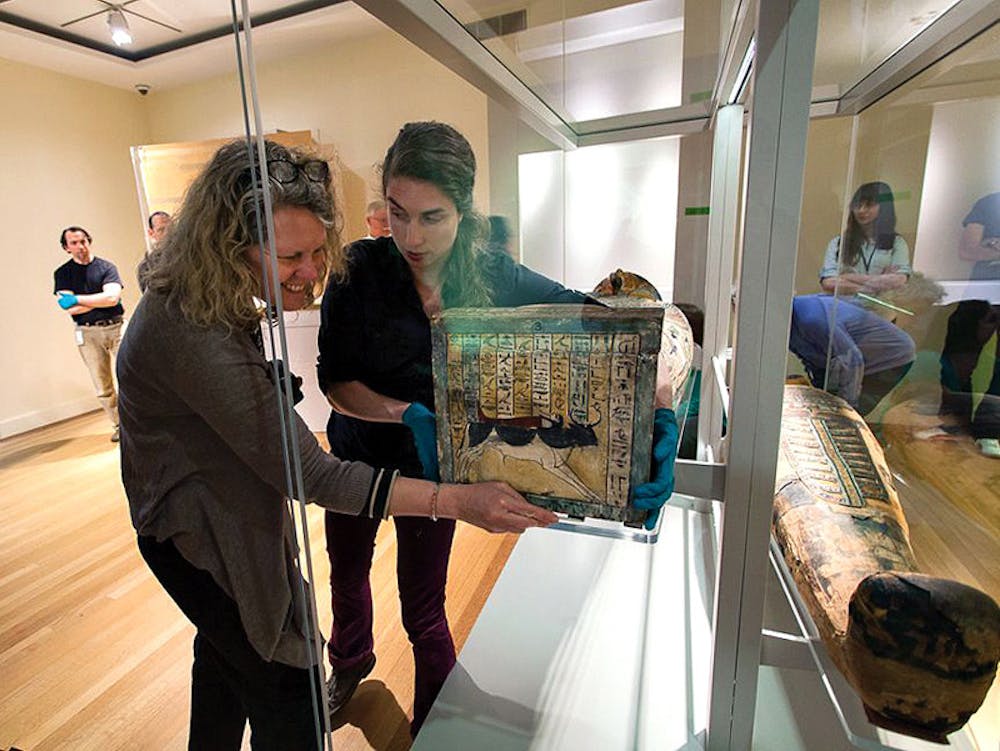Restoration of the nearly 10-foot-tall Dainichi Nyorai Buddha and the newly displayed interior of Egyptian priest Nesmin’s coffin are just two of the many changes visitors will notice in the renovated section of the sixth floor of the Rhode Island School of Design Museum.
The museum opened its restored ancient Egyptian and Asian art galleries, as well as new costume and textile galleries, to the public June 13. The completion of these renovations marks the end of the seven-year-long Radeke Restoration Project — a project that comprises the renovation of three floors of the museum’s historic Eliza G. Radeke Building. Work done on these sixth-floor galleries cost $2.7 million of the project’s $8.4 million dollar budget.
The project was developed to not only restore the historical character of the Eliza G. Radeke Building but also to revitalize, rearrange and re-present the art collections on each floor. The seven-year-long project occured in three phases. Third floor renovations began in 2008, work on the fifth floor in 2010 and remodeling of the sixth floor in May 2013. Renovations of the sixth floor include new climate-controlled and adaptable display cases, a study center that allows more personal access to textiles and costumes, paneled walls for the display of prints, new lighting and Wi-Fi access.
“Throughout this project, our goal has been not only restoring the original architectural integrity of the Radeke building, but to ensure the RISD Museum’s relevance as a vital center for art and design for 21st-century audiences,” said John Smith, director of the RISD Museum, according to a press release.
Between the ancient and the modern, “there’s a play — we like to play,” said Gina Borromeo, curator of ancient art.
She and the other curators, along with members of the education department and the former director of planning, originally met and discussed how to best arrange the floor in a cohesive way. Borromeo said they settled on the theme of materials — how objects are made, what objects are made of and the techniques used to create objects.
Each curator then worked individually to select the pieces they wanted to display in their exhibits. Some pieces were purchased and some were gifted, but most were in the old galleries or pulled from storage, Borromeo said.
“What I brought out is what best fit into the story” of each gallery, she said, adding that she also considered the quality of the pieces. An in-house conservator cleaned and stabilized the pieces she selected.
“People always want to know how (the Egyptians) could possibly have done this given the materials they had,” she said. The pieces on display, which are grouped by material and in cases that allow visitors to see unfinished areas, reveal the artistic process and the cultural significance of the materials.
The Asian art gallery places pieces made in different Asian cultures, but from similar materials, in adjacent displays.
Mixing pieces from various Asian cultures allows viewers to see the range of cultural uses for one material, Borromeo said, adding that it also permits the museum to highlight the strengths of the smaller art collections.
While the Asian and ancient Egyptian art collections were reorganized and reinterpreted, it is the first time that a selection of the museum’s 26,000-piece collection of textiles and costumes will have their own display, Smith wrote in an email to The Herald. The pieces on exhibit in the new Angelo Donghia Costume and Textiles Gallery will change semi-annually and currently demonstrate the cross-cultural uses of the floral motif.
“I wanted to fully embrace the opportunity that this new space gives us to highlight not only the riches but also geographic and chronological breadth, of our departmental holdings,” Kate Irvin, curator of costumes and textiles wrote in an email to The Herald.
A study center adjacent to the costume and textile gallery was also established as part of the renovation. The new study room displays costumes and textiles in glass-covered drawers and features iPads that present the information about each piece on display.
The museum renovations were completed with RISD students in mind, Borromeo said. The study room holds classes for them, and pieces on display change with the needs of the class. A central case with glass-covered pull-out drawers allows students to “directly interact with objects that will inspire them, or not,” she added. “The collection is very much alive for them.”
The restoration project compiled an interactive section of the museum’s website that displays an image of the piece, and provides both the artist’s interpretation and the critique of a scholar or historian. This juxtaposition of viewpoints melds with the theme of the new galleries, presenting the ideas of both the maker and the scholar, Borromeo said.
“The Radeke building is in many ways the RISD Museum’s core, and it is where we exhibit the most significant works from our permanent collection,” Smith wrote. “It had been several decades since the Radeke building’s galleries had been upgraded, so the project was long overdue.”

ADVERTISEMENT




